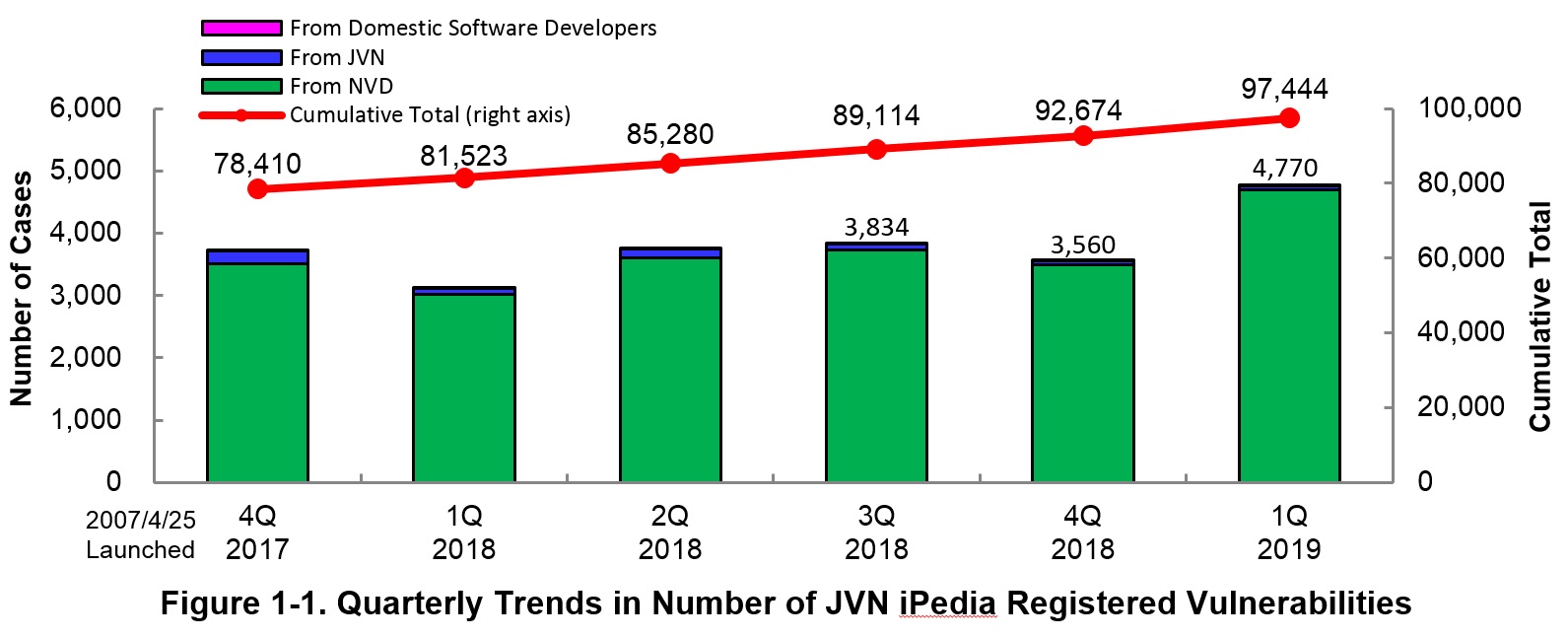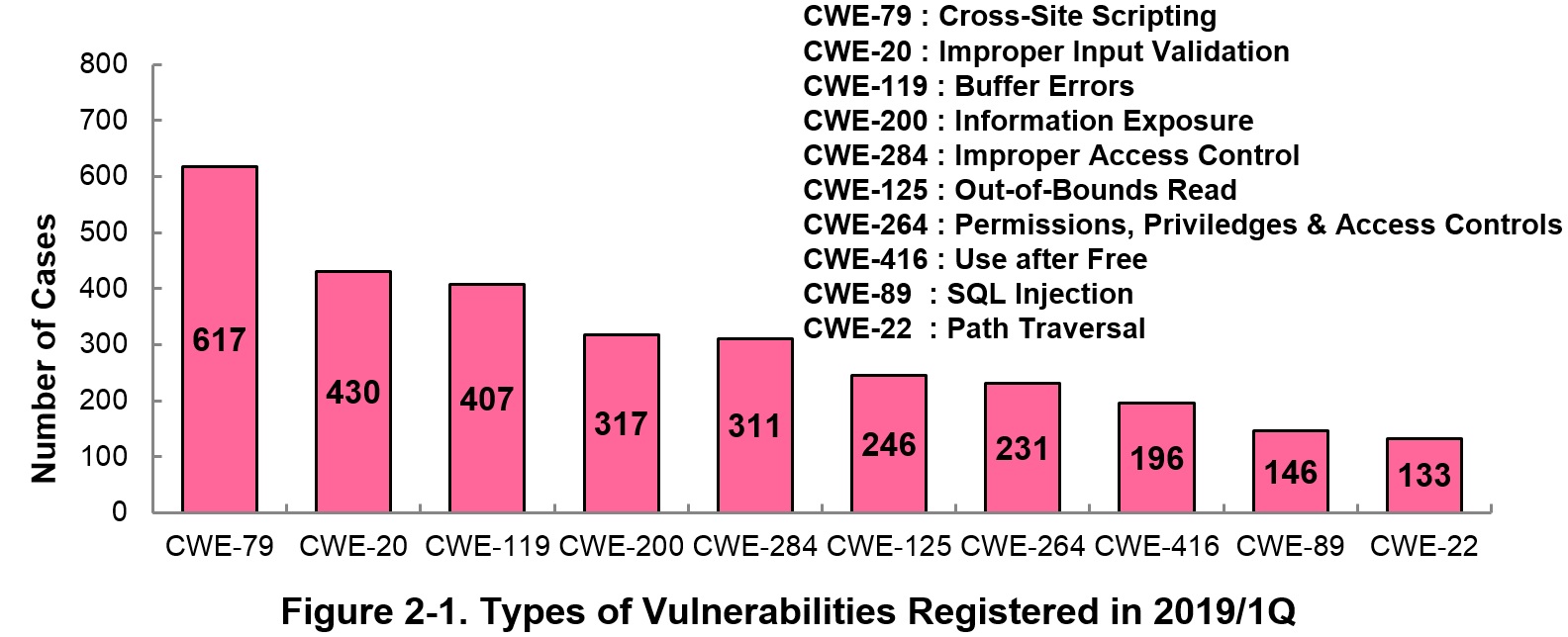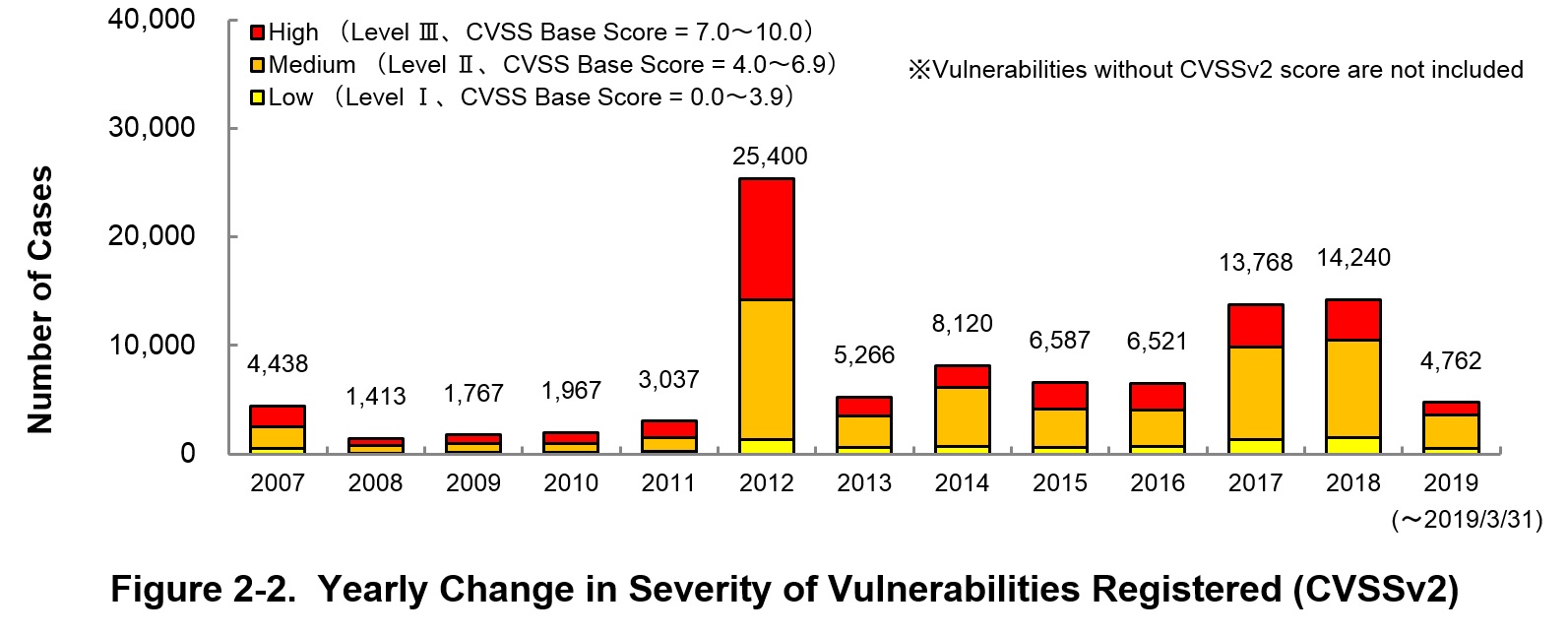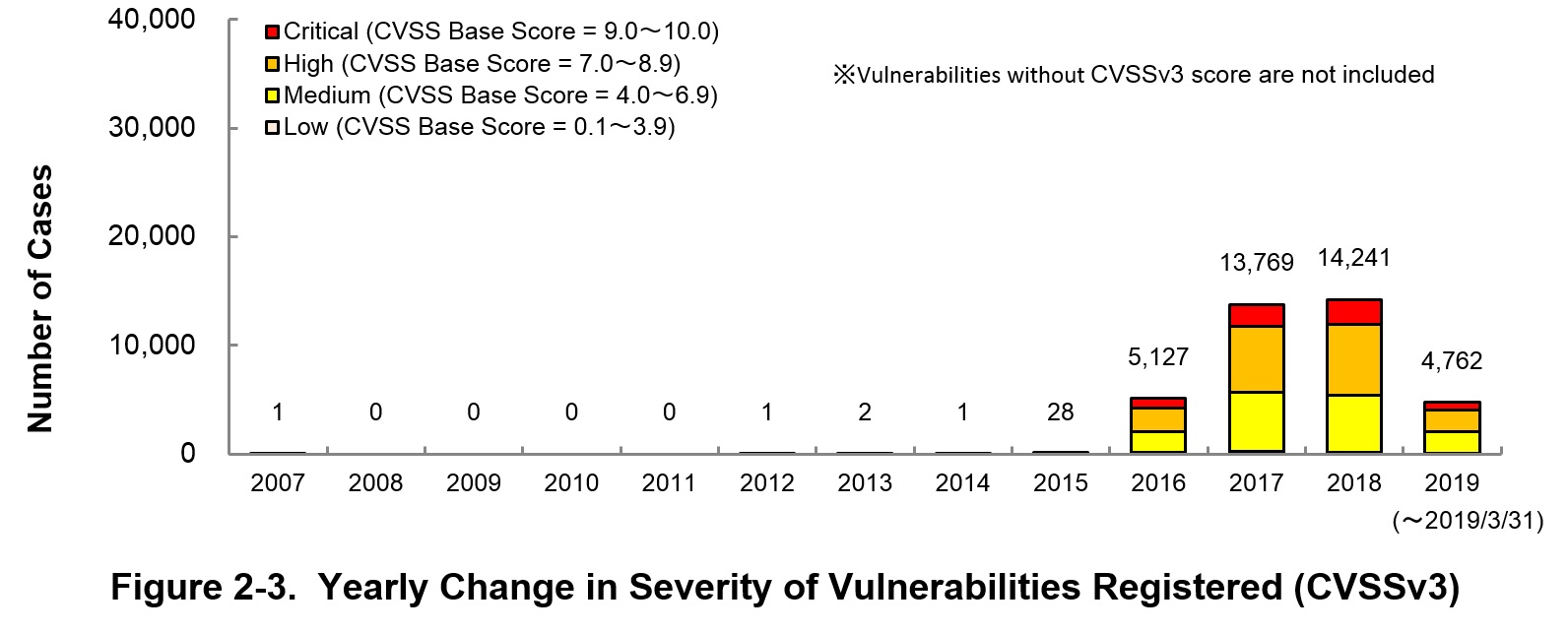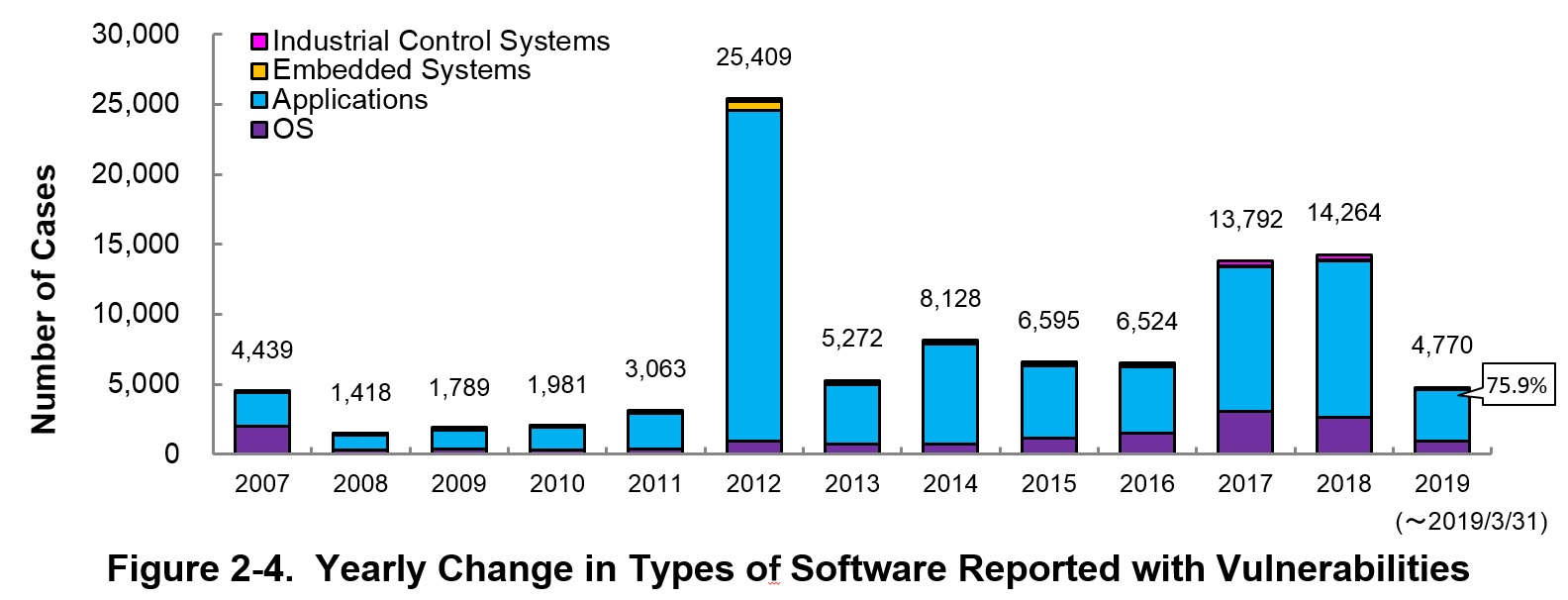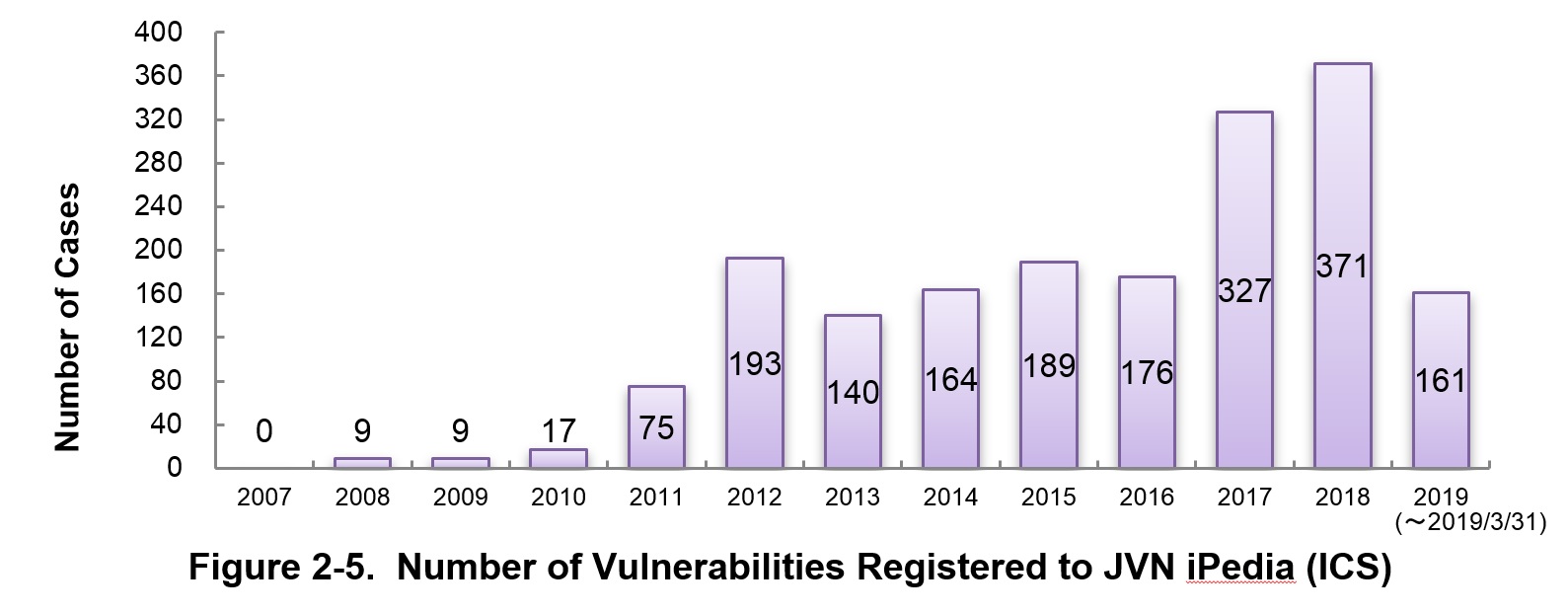Enhancing information security

Vulnerability Countermeasure Information Database JVN iPedia Registration Status [2019 1st Quarter (Jan. - Mar.)]
Release Date:May 19, 2019
IT Security Center
1. 2019 1st Quarter: Vulnerability Countermeasure Information Database JVN iPedia Registration Status
The vulnerability countermeasure information database JVN iPedia (https://jvndb.jvn.jp/en/) is endeavoring to become a comprehensive vulnerability database where vulnerability information is aggregated for easy access for IT users. JVN iPedia collects and/or translates the vulnerability information published by 1) domestic software developers, 2) JVN (*1), a vulnerability information portal run by JPCERT/CC and IPA, and 3) NVD (*2), a vulnerability database run by NIST (*3). JVN iPedia has been making vulnerability information available to the public since April 25, 2007.
1-1. Vulnerabilities Registered in 2019/1Q
~ JVN iPedia now stores 97,444 vulnerabilities ~
The summary of the vulnerability information registered to the Japanese version of JVN iPedia during the 1st quarter of 2019 (January 1 to March 31, 2019) is shown in the table below. As of the end of March 2019, the total number of vulnerabilities stored in JVN iPedia is 97,444 (Table 1-1, Figure 1-1).
As for the JVN iPedia English version, the total number of vulnerabilities stored is 2,018 as shown in the lower half of the Table 1-1.
Table 1-1. Vulnerabilities Registered to JVN iPedia during 1st Quarter of 2019
|
|
Information Source
|
Registered Cases
|
Cumulative Cases
|
|---|---|---|---|
|
Japanese Version
|
Domestic Product Developers
|
3 cases
|
213 cases
|
|
JVN
|
76 cases
|
8,437 cases
|
|
|
NVD
|
4,691 cases
|
88,884 cases
|
|
|
Total
|
4,770 cases
|
97,444 cases
|
|
|
English Version
|
Domestic Product Developers
|
3 cases
|
213 cases
|
|
JVN
|
18 cases
|
1,805 cases
|
|
|
Total
|
21 cases
|
2,018 cases
|
2. Details on JVN iPedia Registered Data
2-1. Types of Vulnerabilities Reported
Figure 2-1 shows the number of vulnerabilities newly added to JVN iPedia during the 1st quarter of 2019, sorted by the CWE vulnerability types.
The type of the vulnerabilities reported most in the 1st quarter is CWE-79 (Cross-Site Scripting) with 617 cases, followed by CWE-20 (Improper Input Validation) with 430, CWE-119 (Improper Restriction of Operations within the Bounds of a Memory Buffer (Buffer Errors)) with 407, CWE-200 (Information Exposure) with 317, CWE-284 (Improper Access Control) with 311.
CWE-79, the most reported vulnerability type in this quarter, could allow attackers to display false webpages and/or steal information.
Software developers need to make sure to mitigate vulnerability from the planning and design phase of software development. IPA provides tools and guidelines, such as "How to Secure Your Website" (*4), "Secure Programing Guide" (*5) and "AppGoat" (*6), a hands-on venerability learning tool, for website developers and operators to build secure websites.
2-2. Severity of Vulnerabilities Reported
Figure 2-2 shows the yearly change in the CVSSv2 rating scale based severity of vulnerabilities registered to JVN iPedia.
As for the vulnerabilities added to JVN iPedia in 2019, 24.2 percent are "level III" (7.0 - 10.0), 64.3 percent are "level ll" (4.0 – 6.9) and 11.5 percent are "level I" (0.0 – 3.9). This means 88.5 percent of all vulnerabilities registered are level II or higher, which are potentially critical enough to cause damage like information exposure or data modification.
Figure 2-3 shows the yearly change in the CVSSv3 rating scale based severity of vulnerabilities registered to JVN iPedia.
As for the vulnerabilities added to JVN iPedia in 2019, 15.3 percent are "Critical" (9.0 – 10.0), 42.3 percent are "High" (7.0 – 8.9), 41.5 percent are "Medium" (4.0 – 6.9) and 0.9 percent are "Low" (0.1 – 3.9).
To avoid threats posed by the known vulnerabilities, both product developers and IT users should pay close attention to vulnerability disclosure and update software they use to a fixed version or apply a security patch as soon as possible when they become available. IT users can check vulnerabilities newly published on JVN iPedia in RSS and XML format (*7) as well.
2-3. Types of Software Reported with Vulnerability
Figure 2-4 shows the yearly change in the type of software reported with vulnerability. Application vulnerabilities have been published most, accounting for 75.9 percent (3,621 out of 4,770) of the 2019 total.
Figure 2-5 shows the yearly change in the number of JVN iPedia-stored vulnerabilities in industrial control systems (ICS) used in critical infrastructure sectors. As of March 2019, the total of 1,831 ICS vulnerabilities have been registered.
2-4. Products Reported with Vulnerability
Table 2-1 lists the top 20 software whose vulnerabilities were most registered to JVN iPedia during the 1st quarter (January to March) of 2019.
In this quarter, Debian GNU/Linux is the 1st rank which continued from the previous quarter (2018 Q4). Debian GNU/Linux is provided by integrating the OS and over 50,000 software packages so that Debian GNU/Linux fix the vulnerabilities according to the fix of the vulnerabilities of those packages. Accordingly, it is thought that the number of registered Debian GNU/Linux continues to be high (*8).
Besides those in the top 20 list, JVN iPedia stores and offers vulnerability information about a variety of software. IPA hopes software developers and users will make good use of JVN iPedia to efficiently check vulnerability information and take necessary action in a timely manner (*9).
Table 2-1. Top 20 Software Products Vulnerabilities Were Most Registered [Jan. – Mar. 2019]
|
Rank
|
Category
|
Product Name (Vendor)
|
Number of
Vulnerabilities Registered |
|---|---|---|---|
|
1
|
OS
|
Debian GNU/Linux (Debian)
|
401
|
|
2
|
OS
|
Red Hat Enterprise Linux Server (Red Hat)
|
246
|
|
3
|
OS
|
Red Hat Enterprise Linux Workstation (Red Hat)
|
237
|
|
4
|
OS
|
Red Hat Enterprise Linux Desktop (Red Hat)
|
236
|
|
5
|
Browser
|
Google Chrome (Google)
|
203
|
|
6
|
OS
|
Ubuntu (Canonical)
|
186
|
|
7
|
OS
|
Android (Google)
|
167
|
|
8
|
Firmware
|
Qualcomm firmware (Qualcomm) (*10)
|
113
|
|
9
|
PDF Viewer
|
Foxit Reader (Foxit Software Inc)
|
108
|
|
10
|
PDF Viewer/Editor
|
Foxit PhantomPDF (Foxit Software Inc)
|
94
|
|
11
|
PDF Viewer/Editor
|
Adobe Acrobat (Adobe Systems)
|
92
|
|
11
|
PDF Viewer
|
Adobe Acrobat Reader DC (Adobe Systems)
|
92
|
|
11
|
PDF Viewer/Editor
|
Adobe Acrobat DC (Adobe Systems)
|
92
|
|
14
|
OS
|
Microsoft Windows 10 (Microsoft)
|
44
|
|
14
|
OS
|
Microsoft Windows Server (Microsoft)
|
44
|
|
16
|
Video Surveillance Software
|
ZoneMinder (ZoneMinder)
|
41
|
|
17
|
OS
|
Microsoft Windows Server 2019 (Microsoft)
|
39
|
|
18
|
OS
|
Microsoft Windows Server 2016 (Microsoft)
|
38
|
|
19
|
Browser
|
Mozilla Firefox (Mozilla Foundation)
|
36
|
|
20
|
OS
|
Linux Kernel (Kernel.org)
|
33
|
3. Most Accessed Vulnerability Countermeasure Information
Table 3-1 lists the top 20 most accessed vulnerability information in JVN iPedia during the 1st quarter of 2019 (January to March).
Of the vulnerability countermeasure information ranked high in this quarter, the 3rd, 6th, 9th, 13th rank were collected from domestic product developers. Except for the above and the 5th rank, 15 are vulnerability countermeasure information released on the Vulnerability Countermeasure Information Portal Site JVN. Those products registered in the vulnerability countermeasure information have many domestic users and receive a lot of attention so that the number of access the relevant web site tend to increase.
Rating Scale
Note 1) CVSSv2 Severity Rating Scale
- Level I (Low)
- CVSS Base Score = 0.0~3.9
- Level II (Medium)
- CVSS Base Score = 4.0~6.9
- Level III (High)
- CVSS Base Score = 7.0~10.0
Note 2) CVSSv3 Severity Rating Scale
- Low
- CVSS Base Score =0.1~3.9
- Medium
- CVSS Base Score =4.0~6.9
- High
- CVSS Base Score =7.0~8.9
- Critical
- CVSS Base Score =9.0~10.0
Table 3-1. Top 20 Most Accessed Vulnerability Countermeasure Information in JVN iPedia [Jan. – Mar. 2019]
No.1 WordPress plugin "spam-byebye" vulnerable to cross-site scripting JVNDB-2019-000001
- CVSSv2 Severity Rating Scale
-
- Level I (Low)
- CVSSv2 Base Score
-
2.6
- CVSSv3 Severity Rating Scale
-
- Medium
- CVSSv3 Base Score
-
6.1
- Date Public
-
2019/1/10
- Access Count
-
6,672
No.2 GROWI vulnerable to cross-site scripting JVNDB-2018-000137
- CVSSv2 Severity Rating Scale
-
- Level II (Medium)
- CVSSv2 Base Score
-
4.0
- CVSSv3 Severity Rating Scale
-
Medium
- CVSSv3 Base Score
-
5.4
- Date Public
-
2018/12/26
- Access Count
-
6,548
No.3 Clickjacking Vulnerability in Hitachi Automation Director JVNDB-2018-010851
- CVSSv2 Severity Rating Scale
-
Level II (Medium)
- CVSSv2 Base Score
-
4.3
- CVSSv3 Severity Rating Scale
-
Medium
- CVSSv3 Base Score
-
4.3
- Date Public
-
2018/12/26
- Access Count
-
6,379
No.4 HOUSE GATE App for iOS vulnerable to directory traversal JVNDB-2019-000003
- CVSSv2 Severity Rating Scale
-
Level II (Medium)
- CVSSv2 Base Score
-
4.3
- CVSSv3 Severity Rating Scale
-
Medium
- CVSSv3 Base Score
-
4.7
- Date Public
-
2019/1/24
- Access Count
-
6,354
No.5 Cross-site Scripting Vulnerability in OpenKM JVNDB-2014-007972
- CVSSv2 Severity Rating Scale
-
Level I (Low)
- CVSSv2 Base Score
-
3.5
- CVSSv3 Base Score
-
-
- Date Public
-
2015/3/13
- Access Count
-
5,978
No.6 Cross-site Scripting Vulnerability in Hitachi Device Manager JVNDB-2019-001095
- CVSSv2 Severity Rating Scale
-
- Level II (Medium)
- CVSSv2 Base Score
-
4.0
- CVSSv3 Severity Rating Scale
-
- Medium
- CVSSv3 Base Score
-
4.7
- Date Public
-
2019/1/22
- Access Count
-
5,717
No.7 WordPress plugin "Google XML Sitemaps" vulnerable to cross-site scripting JVNDB-2018-000135
- CVSSv2 Severity Rating Scale
-
- Level II (Medium)
- CVSSv2 Base Score
-
4.0
- CVSSv3 Severity Rating Scale
-
Medium
- CVSSv3 Base Score
-
4.8
- Date Public
-
2018/12/25
- Access Count
-
5,495
No.8 PgpoolAdmin fails to restrict access permissions JVNDB-2018-000134
- CVSSv2 Severity Rating Scale
-
Level III (High)
- CVSSv2 Base Score
-
7.5
- CVSSv3 Severity Rating Scale
-
Critical
- CVSSv3 Base Score
-
9.8
- Date Public
-
2018/12/21
- Access Count
-
5,448
No.9 Information Disclosure Vulnerability in Hitachi Command Suite and Hitachi Infrastructure Analytics Advisor JVNDB-2019-001094
- CVSSv2 Severity Rating Scale
-
Level II (Medium)
- CVSSv2 Base Score
-
5.0
- CVSSv3 Severity Rating Scale
-
Medium
- CVSSv3 Base Score
-
5.3
- Date Public
-
2019/1/22
- Access Count
-
5,420
No.10 Installer of Mapping Tool may insecurely load Dynamic Link Libraries JVNDB-2018-000136
- CVSSv2 Severity Rating Scale
-
Level II (Medium)
- CVSSv2 Base Score
-
6.8
- CVSSv3 Severity Rating Scale
-
High
- CVSSv3 Base Score
-
7.8
- Date Public
-
2018/12/25
- Access Count
-
5,237
No.11 cordova-plugin-ionic-webview vulnerable to path traversal JVNDB-2018-000133
- CVSSv2 Severity Rating Scale
-
- Level II (Medium)
- CVSSv2 Base Score
-
4.3
- CVSSv3 Severity Rating Scale
-
- Medium
- CVSSv3 Base Score
-
4.7
- Date Public
-
2018/12/21
- Access Count
-
5,199
No.12 POWER EGG vulnerability where EL expression may be executed JVNDB-2019-000006
- CVSSv2 Severity Rating Scale
-
- Level III (High)
- CVSSv2 Base Score
-
7.5
- CVSSv3 Severity Rating Scale
-
High
- CVSSv3 Base Score
-
7.3
- Date Public
-
2019/2/5
- Access Count
-
5,041
No.13 Problem with directory permissions in JP1/Operations Analytics JVNDB-2018-010027
- CVSSv2 Severity Rating Scale
-
Level I (Low)
- CVSSv2 Base Score
-
3.5
- CVSSv3 Severity Rating Scale
-
4.9
- CVSSv3 Base Score
-
Medium
- Date Public
-
2018/12/4
- Access Count
-
5,009
No.14 Multiple vulnerabilities in i-FILTER JVNDB-2018-000129
- CVSSv2 Severity Rating Scale
-
Level II (Medium)
- CVSSv2 Base Score
-
4.3
- CVSSv3 Severity Rating Scale
-
Medium
- CVSSv3 Base Score
-
6.1
- Date Public
-
2018/12/7
- Access Count
-
4,992
No.15 Multiple vulnerabilities in Toshiba Lighting & Technology Corporation Home gateway JVNDB-2018-000132
- CVSSv2 Severity Rating Scale
-
Level III (High)
- CVSSv2 Base Score
-
8.3
- CVSSv3 Severity Rating Scale
-
High
- CVSSv3 Base Score
-
8.8
- Date Public
-
2018/12/19
- Access Count
-
4,890
No.16 Lhaplus vulnerable to improper verification when expanding ZIP64 archives JVNDB-2018-000001
- CVSSv2 Severity Rating Scale
-
- Level II (Medium)
- CVSSv2 Base Score
-
4.3
- CVSSv3 Severity Rating Scale
-
- Low
- CVSSv3 Base Score
-
3.3
- Date Public
-
2018/1/11
- Access Count
-
4,801
No.17 azure-umqtt-c vulnerable to denial-of-service (DoS) JVNDB-2019-000010
- CVSSv2 Severity Rating Scale
-
- Level II (Medium)
- CVSSv2 Base Score
-
5.0
- CVSSv3 Severity Rating Scale
-
High
- CVSSv3 Base Score
-
7.5
- Date Public
-
2019/2/20
- Access Count
-
4,759
No.18 UNLHA32.DLL, UNARJ32.DLL, LHMelting and LMLzh32.DLL may insecurely load Dynamic Link Libraries JVNDB-2019-000004
- CVSSv2 Severity Rating Scale
-
Level II (Medium)
- CVSSv2 Base Score
-
6.8
- CVSSv3 Severity Rating Scale
-
High
- CVSSv3 Base Score
-
7.8
- Date Public
-
2019/1/31
- Access Count
-
4,699
No.19 Multiple vulnerabilities in RICOH Interactive Whiteboard JVNDB-2018-000124
- CVSSv2 Severity Rating Scale
-
Level III (High)
- CVSSv2 Base Score
-
10.0
- CVSSv3 Severity Rating Scale
-
Critical
- CVSSv3 Base Score
-
9.8
- Date Public
-
2018/11/27
- Access Count
-
4,666
No.20 Multiple vulnerabilities in Aterm WF1200CR and Aterm WG1200CR JVNDB-2018-000131
- CVSSv2 Severity Rating Scale
-
Level II (Medium)
- CVSSv2 Base Score
-
5.8
- CVSSv3 Severity Rating Scale
-
High
- CVSSv3 Base Score
-
8.8
- Date Public
-
2018/12/14
- Access Count
-
4,662
Table 3-2 lists the top 5 most accessed vulnerability information among those reported by domestic product developers.
Table 3-2. Top 5 Most Accessed Vulnerabilities Reported by Domestic Product Developers [Jan. - Mar. 2019]
No.1 Clickjacking Vulnerability in Hitachi Automation Director JVNDB-2018-010851
- CVSSv2 Severity Rating Scale
-
Level II (Medium)
- CVSSv2 Base Score
-
- 4.3
- CVSSv3 Severity Rating Scale
-
Medium
- CVSSv3 Base Score
-
- 4.3
- Date Public
-
2018/12/26
- Access Count
-
6,379
No.2 Cross-site Scripting Vulnerability in Hitachi Device Manager JVNDB-2019-001095
- CVSSv2 Severity Rating Scale
-
Level II (Medium)
- CVSSv2 Base Score
-
- 4.0
- CVSSv3 Severity Rating Scale
-
Medium
- CVSSv3 Base Score
-
4.7
- Date Public
-
2019/1/22
- Access Count
-
5,717
No.3 Information Disclosure Vulnerability in Hitachi Command Suite and Hitachi Infrastructure Analytics Advisor JVNDB-2019-001094
- CVSSv2 Severity Rating Scale
-
Level II (Medium)
- CVSSv2 Base Score
-
5.0
- CVSSv3 Severity Rating Scale
-
Medium
- CVSSv3 Base Score
-
5.3
- Date Public
-
2019/1/22
- Access Count
-
5,420
No.4 Problem with directory permissions in JP1/Operations Analytics JVNDB-2018-010027
- CVSSv2 Severity Rating Scale
-
Level I (Low)
- CVSSv2 Base Score
-
3.5
- CVSSv3 Severity Rating Scale
-
Medium
- CVSSv3 Base Score
-
4.9
- Date Public
-
2018/12/4
- Access Count
-
5,009
No.5 Multiple Vulnerabilities in JP1/VERITAS JVNDB-2018-009328
- CVSSv2 Severity Rating Scale
-
Level III (High)
- CVSSv2 Base Score
-
10.0
- CVSSv3 Severity Rating Scale
-
Critical
- CVSSv3 Base Score
-
9.8
- Date Public
-
2018/11/15
- Access Count
-
4,521
Footnotes
-
(*1)
-
(*2)
-
(*3)
-
(*4)
-
(*5)
-
(*6)
-
(*7)
-
(*8)
-
(*9)
-
(*10)'Qualcomm Firmware' contains various firmware of Qualcomm processors such as SD and MSM series.
Past Quarterly Reports
Contact information
IT Security Center,
Information-technology Promotion Agency, Japan (ISEC/IPA)

